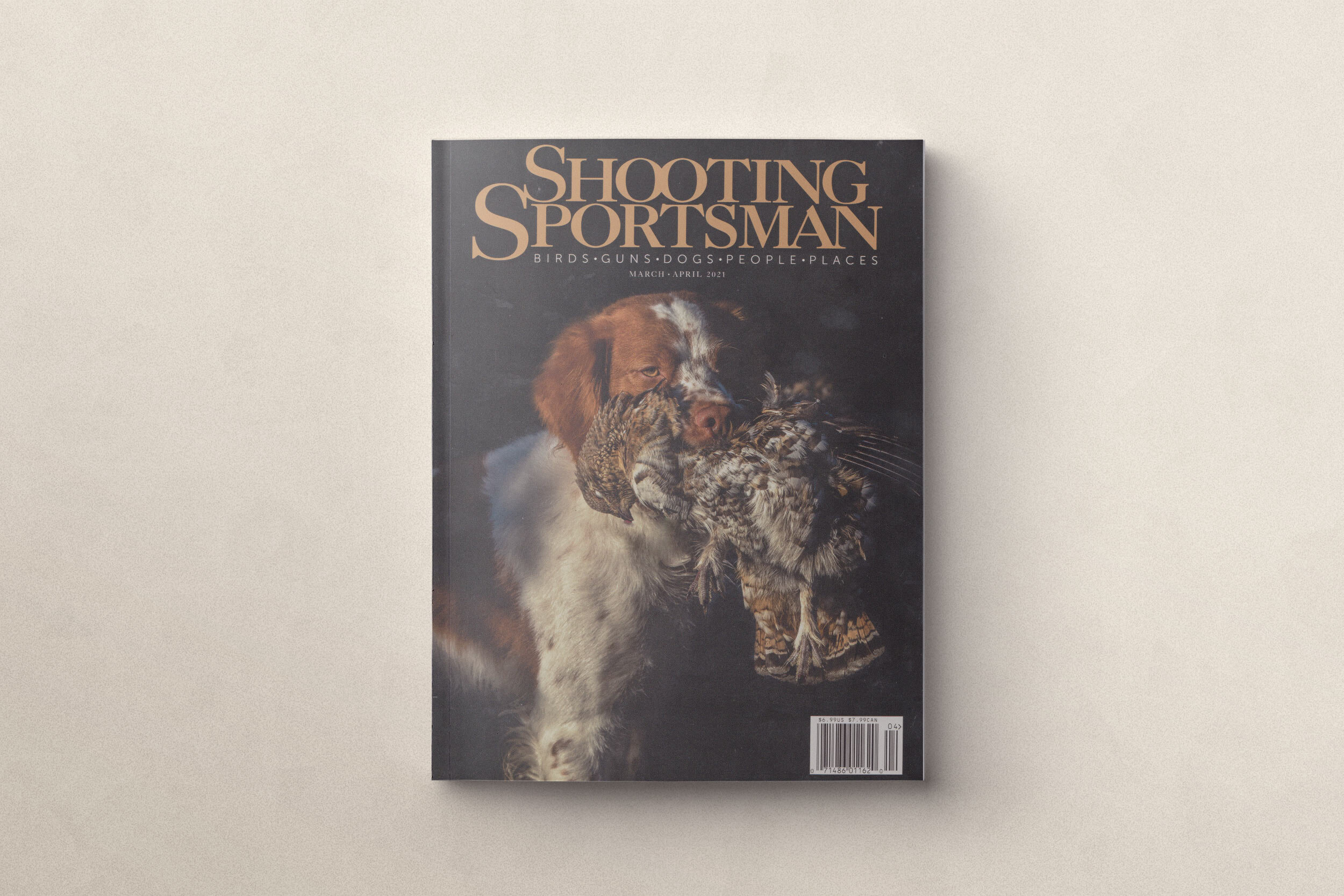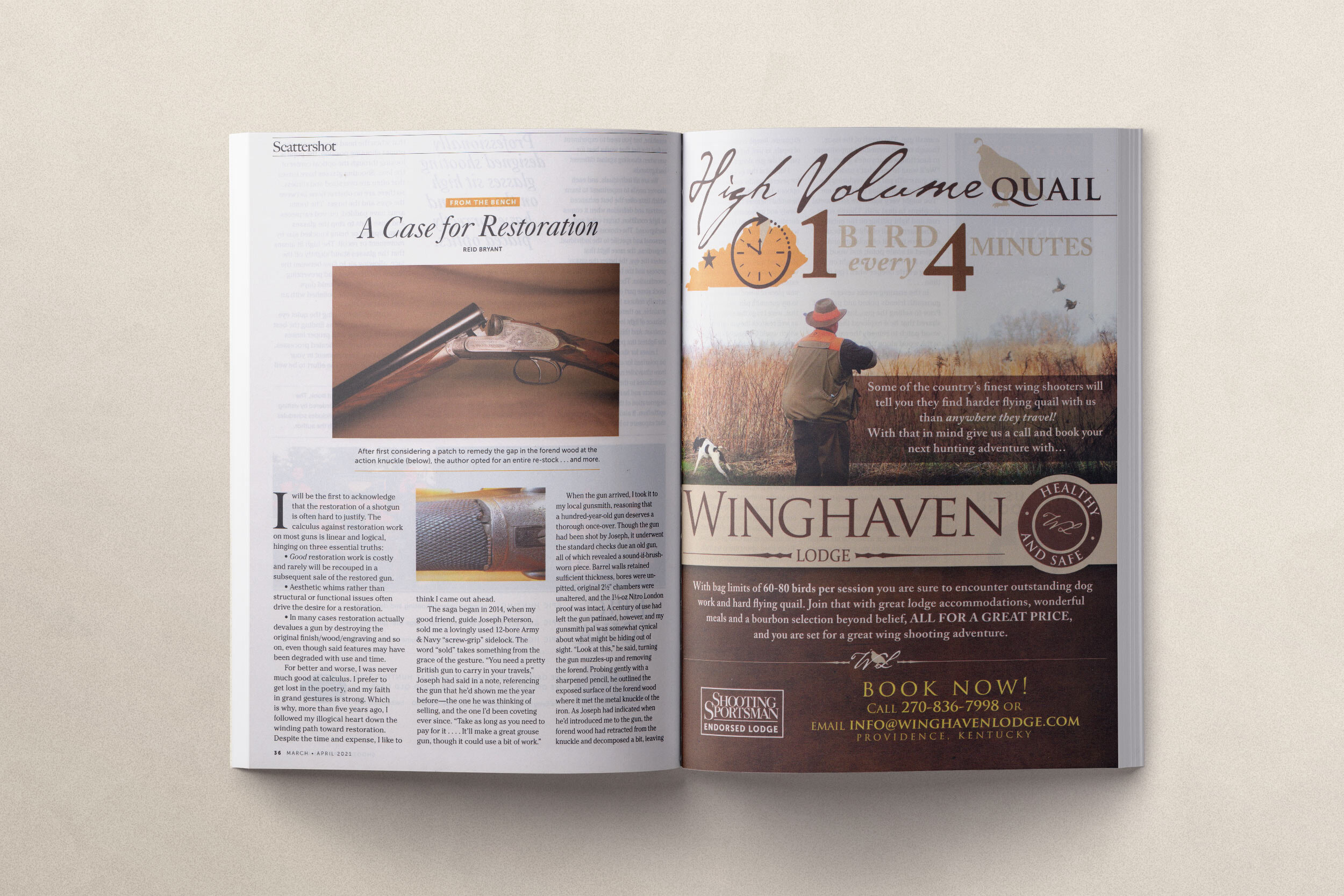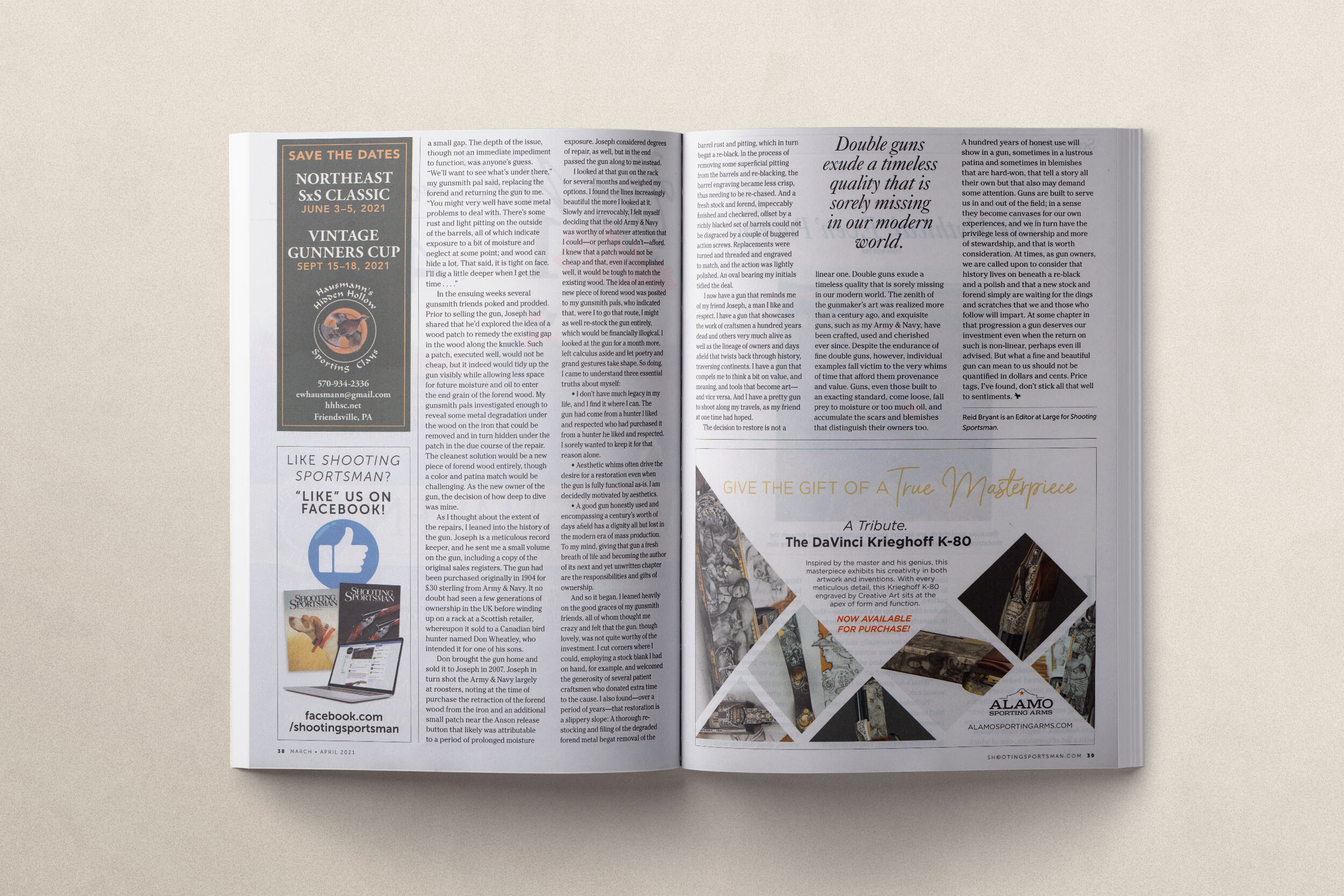A Case for Restoration
Iwill be the first to acknowledge that the restoration of a shotgun is often hard to justify. The calculus against restoration work on most guns is linear and logical, hinging on three essential truths:
GOOD restoration work is costly, often prohibitively so, and will rarely be recouped in a subsequent sale of the restored gun.
Aesthetic whims rather than structural or functional issues often drive the desire for a restoration.
In many cases, restoration devalues the gun by destroying the original finish/wood/engraving etc., even though said features may have been degraded with use and time.
For better and worse, I was never much good at calculus. I prefer to get lost in the poetry, and my faith in grand gestures is strong. Which is why, more than five years ago, I followed my illogical heart down the winding path towards restoration. Despite the time and expense, I like to think I came out ahead.
The saga began in 2014, when my good friend, guide Joseph Peterson, sold me a lovingly used 12-bore Army & Navy “screw-grip” sidelock. The word “sold” takes something from the grace of the gesture; “You need a pretty British gun to carry in your travels,” Joseph had said in a note, referencing the gun that he’d shown me the year before, the one he was thinking of selling, and the one I’d been coveting ever since. “Take as long as you need to pay for it… it’ll make a great grouse gun, though it could use a bit of work...”
When the gun arrived, I took it to my local gunsmith, reasoning that a hundred-year-old gun deserves a thorough once-over. Though the Army & Navy had been shot through Joseph’s ownership, it underwent the standard checks due an old gun, all of which revealed a sound if brush-worn piece: barrel walls retained sufficient thickness, bores were un-pitted, original 2 ½ inch chambers were unaltered, and 1 1/8 oz. nitro London proof marks were intact. A century of use had left the gun patinaed, however, and my gunsmith pal was somewhat cynical about what might be hiding out of sight. “Look at this”, he said, turning the gun muzzles-up and removing the forend. Probing gently with a sharpened pencil, he outlined the exposed surface of the forend wood where it met the metal knuckle of the iron. As Joseph had indicated when he introduced me to the gun, the forend wood had retracted from the knuckle and decomposed a bit, leaving a small gap. The depth of the issue, though not an immediate impediment to function, was anyone’s guess. “We will want to see what is under there…” my gunsmith pal said, replacing the forend and returning the gun to me. “You might very well have some metal problems to deal with. There is some rust and light pitting on the outside of the barrels, all of which indicate exposure to a bit of moisture and neglect at some point, and wood can hide a lot. That said, it is tight on face. I’ll dig a little deeper when I get the time…”
In the ensuing weeks, several gunsmith friends poked and prodded. Prior to selling the gun, Joseph shared that he had explored the idea of a wood patch to remedy the existing gap in the wood along the forend knuckle. Such a patch, executed well, would not be cheap, but would indeed tidy the gun up visibly while allowing less space for future moisture and oil to enter the end grain of the forend wood. My gunsmith pals had investigated enough to reveal some metal degradation under the wood on the iron, which could be removed and in turn hidden under the patch in the due course of the repair. The cleanest solution would be a new piece of forend wood entirely, though a color and patina match would be challenging. As the new owner of the gun, the decision of how deep to dive was mine.
As I thought about the extent of the repairs, I leaned into the history of the gun. Joseph is a meticulous record keeper, and he sent me a small volume on the gun, including a copy of the original sales registers. The gun had been purchased originally in 1904 for 30 pounds sterling from Army & Navy. It had no doubt seen a few generations of ownership in the UK before winding up on a rack at a Scottish retailer, whereupon it sold to a Canadian wingshooter named Don Wheatley who intended it for one of his sons. Per a letter from Joseph: “Don and his family were on a shoot in Scotland when one of his boys' firearms failed. He went to a local shop where they picked up the Army & Navy and it followed them back to Canada. Don used a number of guns while hunting with me here in the states, and his wife Eleanor always used her 20 bore Purdey. The boys preferred other guns, so when Don was aging and dispersing his guns, he asked if I would be interested in the A&N sidelock. I was, so did some research and made Don an offer. On a side note, Don started hunting with me while leading groups from the financial world, but after his retirement he continued to come south with his family. On the last few trips his health was failing, so I would go along just to help him with balance and safety, and to keep him company. I was holding onto his shooting vest for balance when he killed his last bird on the wing- a fine shot at a quartering rooster. Don passed a couple years later.
Don sold the gun to Joseph in 2007, and he in turn shot the Army & Navy largely at roosters, noting at the time of purchase the retraction of the forend wood from the iron and an additional small patch near the Anson release button, likely attributable to a period of prolonged moisture exposure. Joseph considered degrees of repair as well, but in the end passed the gun along to me instead.
I looked at that gun on my rack for several months and weighed my options. I found the lines increasingly beautiful the more I looked at it. Slowly and irrevocably I felt myself deciding that the old Army & Navy was worthy of whatever attention that I could, or perhaps couldn’t, afford. I knew that a patch would not be cheap, and even if accomplished well it would be tough to match with the existing wood. The idea of an entirely new piece of forend wood was posited to my gunsmith pals, who indicated that were I to go that route, I might as well re-stock the gun entirely, which would be financially illogical. I looked at the gun for a month more, and left calculus aside, and let poetry and grand gestures take shape. So doing, I came to understand three essential truths about myself:
I don’t have much legacy in my life, and I find it where I can. The gun had come from a hunter I liked and respected, who had purchased it from a hunter he liked and respected. I sorely wanted to keep it for that reason alone.
Aesthetic whims often drive the desire for a restoration even when the gun is fully functional as-is… I am decidedly motivated by aesthetics.
A good gun, honestly used and encompassing a century’s worth of days afield, has a dignity all but lost in the modern era of mass production. To give that gun a fresh breath of life, and to become the author of its next and yet unwritten chapter, is the responsibility and the gift of ownership.
And so it began. I leaned heavily on the good graces of my gunsmith friends, all of whom thought me crazy, and thought the gun, though lovely, not quite worthy of the investment. I cut corners where I could, employing a stock blank that I had on hand, and welcoming the generosity of several patient craftsmen who donated extra time to the cause. And I found, over a period of years, that restoration is a slippery slope: a thorough re-stocking and filing of the degraded forend metal begat removal of the barrel rust and pitting, which in turn begat a re-black. In the process of removing some superficial pitting from the barrels and re-blacking, the barrel engraving became less crisp, thus needing to be re-chased. And a fresh stock and forend, impeccably finished and checkered, offset by a richly blacked set of barrels, could not be disgraced by a couple buggered action screws. Replacements were turned and threaded and engraved to match, and the action was lightly polished. An oval bearing my initials tidied the deal.
I now have a gun that reminds me of my friend Joseph, a man I like and respect. I have a gun that showcases the work of craftsmen a hundred years dead, and other craftsmen still very much alive, and a lineage of owners and days afield that twists back through history, traversing continents. I have a gun that compels me to think a bit on value, and meaning, and tools that become art, and vice versa. And I have a pretty gun to shoot along my travels, as my friend had one time hoped.
The decision to restore is not a linear one. Double guns exude a timeless quality that is sorely missing in our modern world. The zenith of the gunmakers art was realized more than a century ago, and exquisite guns, such as my Army & Navy, have been crafted, used, and cherished ever since. Despite the endurance of fine double guns, however, individual examples fall victim to the very whims of time that afford them provenance and value. Guns, even those built to an exacting standard, come loose, fall prey to moisture or too much oil, accumulate the scars and blemishes that distinguish their owners too. A hundred years of honest use will show in a gun, sometimes in a lustrous patina, and sometimes in blemishes that are hard-won, that tell a story all their own but that also may demand of us some attention. Our guns are built to serve us in and out of the field; in a sense, they become the canvas for our own experience, and we in turn have the privilege less of ownership and more of stewardship, and that is worth consideration. At times, as gun owners, we are called upon to consider that the history lives on beneath a re-black and a polish, and that a new stock and forend are simply waiting for the dings and scratches that we, and those that follow, will impart. At some chapter in that progression, a gun deserves our investment even when the return on such is non-linear, perhaps even ill-advised. But what a fine and beautiful gun can mean to us should not be quantified in dollars and cents. Price tags, I’ve found, don’t stick all that well to sentiments.
First Published in Shooting Sportsman Magazine


